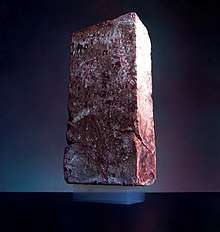FOGBANK
FOGBANK is a code name given to a material used in nuclear weapons such as the W76, W78 and W80.[1]

FOGBANK's precise nature is classified; in the words of former Oak Ridge general manager Dennis Ruddy, "The material is classified. Its composition is classified. Its use in the weapon is classified, and the process itself is classified."[2] Department of Energy Nuclear Explosive Safety documents simply describe it as a material "used in nuclear weapons and nuclear explosives" along with lithium hydride (LiH) and lithium deuteride (LiD), beryllium (Be), uranium hydride (UH3), and plutonium hydride.
However National Nuclear Security Administration (NNSA) Administrator Tom D'Agostino disclosed the role of FOGBANK in the weapon: "There's another material in the—it's called interstage material, also known as fog bank", and arms experts believe that FOGBANK is an aerogel material which acts as an interstage material in a nuclear warhead; i.e., a material designed to become a superheated plasma following the detonation of the weapon's fission stage, the plasma then triggering the fusion-stage detonation.[2]
History
It has been revealed by unclassified official sources that FOGBANK was originally manufactured in Facility 9404-11 of the Y-12 National Security Complex in Oak Ridge, Tennessee from 1975 until 1989, when the final batch of W76 warheads was completed. After that the facility was mothballed, and finally slated for decommissioning by 1993. Only a small pilot plant was left, which had been used to produce small batches of FOGBANK for testing purposes.[2]
In 1996, the US government decided to replace, refurbish, or decommission large numbers of its nuclear weapons. Accordingly, the Department of Energy set up a refurbishment program aimed at extending the service lives of older nuclear weapons. In 2000, the NNSA specified a life-extension program for W76 warheads that would enable them to remain in service until at least 2040.[2]
It was soon realized that the FOGBANK material was a potential source of problems for the program, as few records of its manufacturing process had been retained when it was originally manufactured in the 1980s, and nearly all staff members who had expertise in its production had either retired or left the agency. The NNSA briefly investigated sourcing a substitute for FOGBANK, but eventually decided that since FOGBANK had been produced previously, they would be able to repeat it.[2] Additionally, "Los Alamos computer simulations at that time were not sophisticated enough to determine conclusively that an alternate material would function as effectively as Fogbank," according to a Los Alamos publication.[3]
Manufacture involves the moderately toxic, highly volatile solvent acetonitrile, which presents a hazard for workers (causing three evacuations in March 2006 alone).[1]
With Facility 9404-11 long since decommissioned, a brand new production facility was required. Delays arose during its construction, and in addition, engineers repeatedly encountered failure in their efforts to produce FOGBANK. As one deadline after the other expired, and the schedule was pushed back again and again, the NNSA eventually decided to invest $23 million to attempt to find an alternative to FOGBANK.[2][4][5]
In March 2007, engineers finally devised a manufacturing process for FOGBANK. Unfortunately, the material turned out to have problems when tested, and in September 2007 the FOGBANK project was upgraded to "Code Blue" status by the NNSA, making it a major priority.[2] In 2008, following the expenditure of a further $69 million, the NNSA finally managed to manufacture FOGBANK, and 7 months later, the first refurbished warhead was handed over to the US Navy, nearly a decade after the commencement of the refurbishment program.[2] However, in May 2009 a US Navy spokesman said that they had not received any refurbished weapons to date. The Energy Department stated that the current plan was to begin shipping refurbished weapons in the fall of 2009, two years behind schedule.[6]
The experience of reverse engineering FOGBANK produced some improvements in scientific knowledge of the process. The new production scientists noticed that certain problems in production resembled those noted by the original team. These problems were traced to a particular impurity in the final product that was required to meet quality standards. A root cause investigation showed that input materials were subject to cleaning processes that had not existed during the original production run. This cleaning removed a substance that generated the required impurity. With the implicit role of this substance finally understood, the production scientists can control output quality better than during the original run.[3]
References
- Jeffrey Lewis. "FOGBANK". Arms Control Wonk.
- Last, Jonathan V. (18 May 2009). "The Fog of War: Forgetting what we once knew". The Weekly Standard. 14 (33).
- "Fogbank: Lost Knowledge Regained," (Los Alamos) Nuclear Weapons Journal no. 2 (2009), 20-21.
- Ian Sample (6 March 2008). "Technical hitch delays renewal of nuclear warheads for Trident". The Guardian.
- Rob Edwards (12 March 2008). "Trident missiles delayed by mystery ingredient" (2646): 15. Cite journal requires
|journal=(help)(subscription required) - Ralph Vartabedian (29 May 2009). "Program to refurbish aging nuclear warheads faces setbacks". The Los Angeles Times. ISSN 0458-3035. Retrieved 30 May 2009.